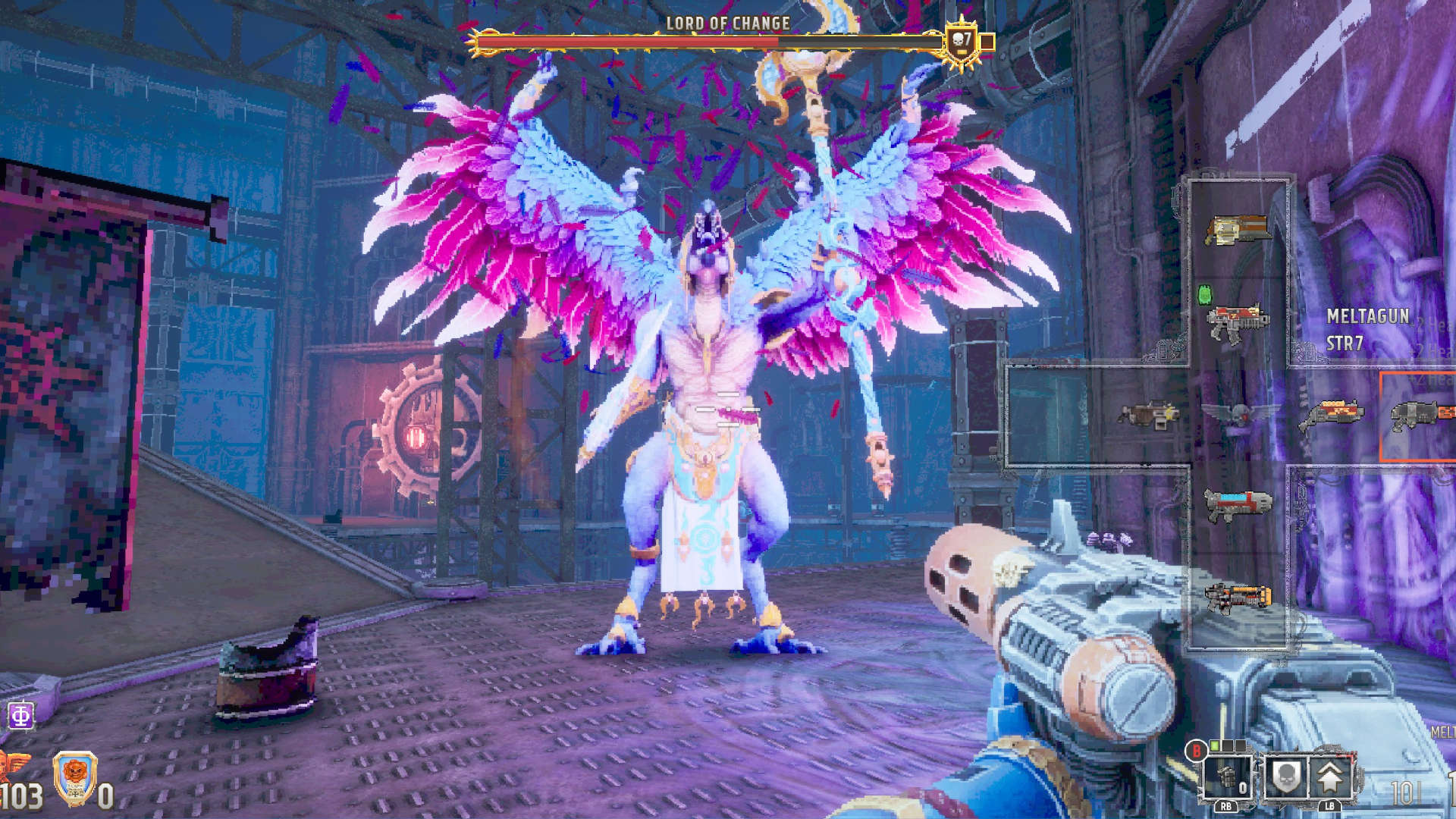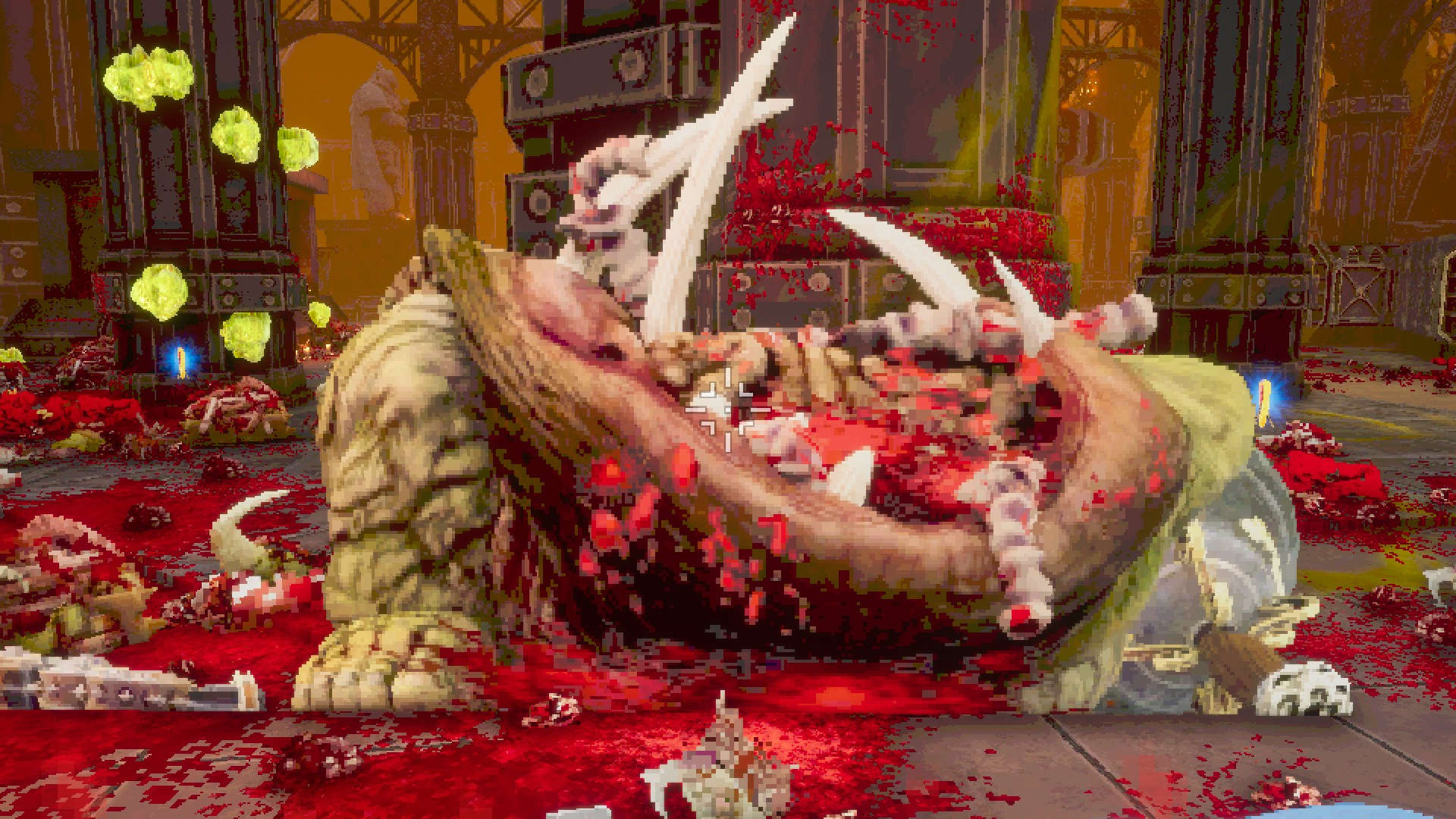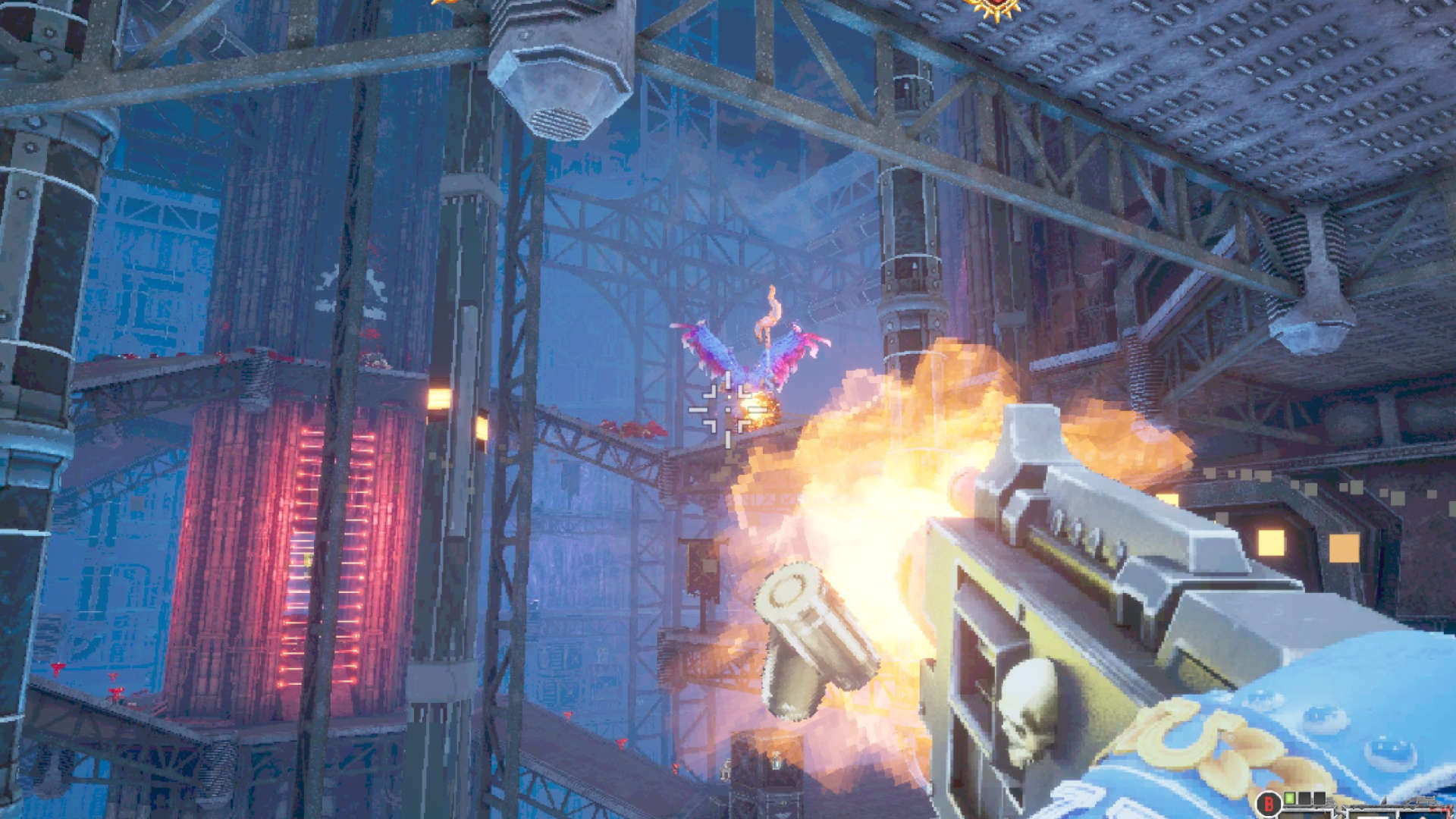Our Verdict
Revelling in 90s FPS excess, Boltgun is fast, furious, and faithful to its two inspirations - Warhammer 40k and retro shooters. Small problems with pacing can't diminish a glorious, gore-ious core loop of fast-paced gunplay.
If you’ve seen the trailer for Warhammer 40k Boltgun you probably know if it’s the kind of game you want to play. A 90s-inspired FPS with retro graphics, retro sensibilities, and all your favorite Space Marine guns, it promises high speed thrills and lots of blood spilled – and for the most part it delivers.
Although there are a good number of Warhammer 40k games on PC and consoles, and the Warhammer 40k factions have produced some of the coolest firearms in all of sci-fi, the franchise has had a middling run with shooters – some good’uns, but none in with a chance of cracking the list of the best FPS games on our sister site PC Games N. Can Boltgun push the bar higher?
There’s a plot, but that’s not important; you’re here to go fast and shoot stuff. I previewed Boltgun in March and just about everything I observed then still stands. Your Space Marine protagonist is extremely mobile, capable of a headlong charge that can flatten smaller enemies or close on distant shooters in a trice, and your chainsword attack comes with its own little dash to deliver the goods nice and fast.
Most of the combat takes place in multi-layered arenas and you’re encouraged to use every level – there’s no fall damage, and weaker enemies splatter underfoot with a rewarding ‘squelch’.
Some arenas are vertiginous: a boss encounter against a Chaos Sorcerer takes place in a chamber so huge you need to teleport from bottom to top, while your flighty quarry zaps between floating platforms and beams you with dark magic.
The game’s armory is a brutal delight. On top of the bolter, shotgun, and plasmagun I got to dally with in the preview, the vengeance launcher is a continuous-fire grenade launcher, perfect for crowd clearance or simply firing on the move; the meltagun unleashes a blast of volcanic death with a roar like a dying god; and the volkite culverin superheats your enemies until they burst.
Best of all, the heavy bolter thunders like an imbalanced two-stroke motorbike engine and makes my controller vibrate so hard it might be damaging the motors. I love the heavy bolter, and not in a pure way. I will marry the heavy bolter. There’s also a grav gun that – according to tooltips – does more damage against stronger foes, but I haven’t been able to play with it yet, for reasons I’ll get into later.
For all the flash and bang, gunplay is quite tactical. Every gun has a strength value and every enemy a toughness value visible on its health bar. Just as in the Warhammer 40k tabletop rules, you’ll struggle to put damage onto an enemy if you’re using a gun with lower strength than its toughness. Then there are enemies like the Pink Screamer which can produce new enemies on death – unless you end their cursed lives with an explosive weapon, ensuring that nothing remains but their giblets.
Enemies are all from the Warhammer 40k Chaos factions, plus a few stray Xenos Ambulls. The models look fantastic converted into sprite art, and I’d like to see DLC for the game if only to see what the studio does with Orks or Tyranids.
Every enemy has a well-defined combat role that makes it a particular flavor of frustration. Nurglings swarm you in droves, forcing you to waste ammo unless you re-equip the crowd-sweeping shotgun or bull charge them out of the way.
Plasma gunner cultists can do significant damage but their projectiles are slow moving; heavy stubber cultists will bracket you with streams of rapid, inaccurate fire; the Chaos Space Marine aspiring champion will run after you with his chain axe, relentlessly, like satan’s own charity mugger.
When everything comes together right, firefights are a riot of explosions, deaths, new enemies teleporting in while you hop, skip, and chainsaw your way around an arena, feverishly swapping out guns, lobbing grenades, and purging heretics by the bucket load.
But it doesn’t always come together. Boltgun has problems with pacing. The fourth level of the game is an absolute brute, a firefight in a mausoleum where plague toads of Nurgle bounce into your face at short range and heavily-armed cultists eviscerate you from a distance. It’s also the end of the preview, and it left me expecting Boltgun to be a very hardcore experience – but level five was almost trivial in comparison.
It was still fun; in fact it was quite cathartic to vent my righteous fury on the fleshy midriffs of countless cultists. I even met my heavy bolter during that level, so it’ll always have a fond spot in my memories.
But it was a bit of a whiplash to come down from such a peak of difficulty. Later boss fights again ramp things up into a brick wall; ballerina dancing around an enemy death swarm is even harder when a Greater Daemon of Tzeentch is trying to barbeque you.
At time of writing I’m stuck fighting a Chaos Sorcerer in a cramped Adeptus Mechanicus facility, and it’s only by looking at the level-select screen that I can tell I’m stuck at the two-thirds mark, not the penultimate mission. The difficulty has been sufficiently inconsistent that I simply couldn’t have guessed how far through the game I was.
Combat arenas all feel like they’d make great multiplayer maps for Unreal Tournament or Quake 4: Arena, but the enemy spawning system doesn’t always apply pressure evenly. New waves of enemies seem to be triggered by killing specific baddies, and if the sole enemy survivor in a huge map is a slow-moving Flamer of Tzeentch, you might find yourself wandering around in relative peace and quiet before you can trigger the next wave.
The artists have done a great job fusing the gothic macro-architecture of Warhammer 40k with the low poly slab-scapes of a classic 90s FPS, but some levels lack identifying features to orient yourself against. Some visual effects also impair legibility: changes to lighting that occur when you’re injured, use certain pickups, or in some indoor areas during lock-in fights, make everything dim and ruddy.
When the game looks good though, it looks incredible. Enemies don’t just die, they disassemble, and they do it differently depending on which form of the Emperor’s mercy you grant them. And those puddles of gore and bits of leg and dripping viscera can be further mulched, squelching under your feet or being pulped like Khorne’s favorite juice drink as you catch them in the heat blast of a melta-gun.
Likewise, the best levels stand out as classics. Chapter one concludes in an Imperial archive partly overwhelmed by the power of chaos; there are monolithic stone fortresses split and hovering in the air, linked by shimmering purple portals, and areas corrupted by a brain-breaking visual effect that I have to assume is painted onto surfaces as a texture but rendered in the foreground of the screen. It’s outstanding.
Retro shooters live and die on the combination of level design, gunplay, and audio-visual feedback; Boltgun nails them, just not all of the time. When it doesn’t I’m willing to forgive it. I’m still riding the high of my last gore-tastic success, and looking forwards to more quality time with the heavy bolter. (We’re very happy together.)
So if you’re considering getting it, I say go for it. I played on standard difficulty; switch to easy mode if you want the catharsis of blasting heretics more than you want a challenge – the core gunplay rocks. And for hardcore FPS fans there are two more difficulty levels, though I’m not Astartes enough to delve into them.
Our sister site The Loadout is tracking if Warhammer 40k Boltgun is coming to Game Pass if you want to hold out for a bargain. Despite the retro looks, the game is a little more hardware intensive than it appears, so if you have an old machine or a laptop you can check the Warhammer 40k Boltgun system requirements with our pals over at PCGameBenchmark.









